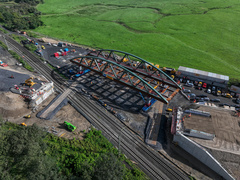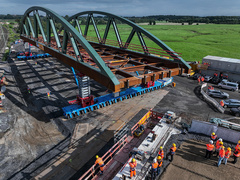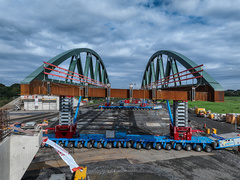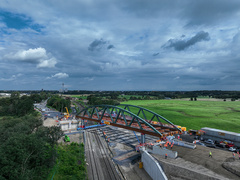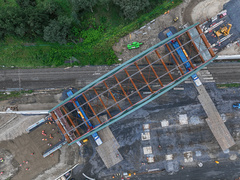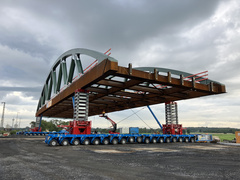Between Emmerich and Oberhausen in North-Rhine Westphalia the railway tracks are being expanded to three tracks. To create space for the third track, construction section 3 (Voerde-Friedrichsfeld/Wesel) requires the renewal of eleven road and railway bridges as well as two stopping points. One of them is the road bridge at Willy-Brandt-Strasse near Wesel which leads national road B8 over the railway tracks. The bridge is too narrow for a new, third track and has thus to be replaced by a new bridge.
The original design was a two-span bridge made of prestressed concrete. This design included a temporary road bridge to be built next to the old bridge to accommodate traffic during the 2.5-year construction period. To minimise restrictions on the highly frequented road as much as possible and to eliminate the construction of the temporary bridge, an alternative structure was chosen, which can be completed much faster by modular construction method and does not require a complicated temporary bridge.
It's a truss arch bridge with a modular deck carriageway and is unique in its implementation. The stiffening girders and the transverse girders are made of weather-resistant structural steel and only the arch and the diagonals are built with regular corrosion-protected steel. This reduces limitations to railway traffic when the corrosion protection requires renewal.
The directly drivable modular slabs are prestressed in longitudinal direction on the bridge by replaceable tension cords. This method compresses the seal elements between the slabs, creating a homogenous carriageway – another asphalt layer is not necessary. In transverse direction of the bridge, the modules are prestressed by cords in the pretensioning bed.
On 31 August, the structure was placed by so-called SPMT. The steel superstructure, earlier welded next to the railway tracks, was lifted and the SPMT were mounted underneath. The existing two tracks were covered so that the SMPT could bring the steel bridge into its place and lower it onto the previously constructed abutments.
Assembly of the modular slabs will be done afterwards by placing them in longitudinal direction on one abutment side and pulling them over the bridge.
The road bridge is built by Deutsche Bahn AG; the structure will then be handed over to the road authorities Straßen NRW.
